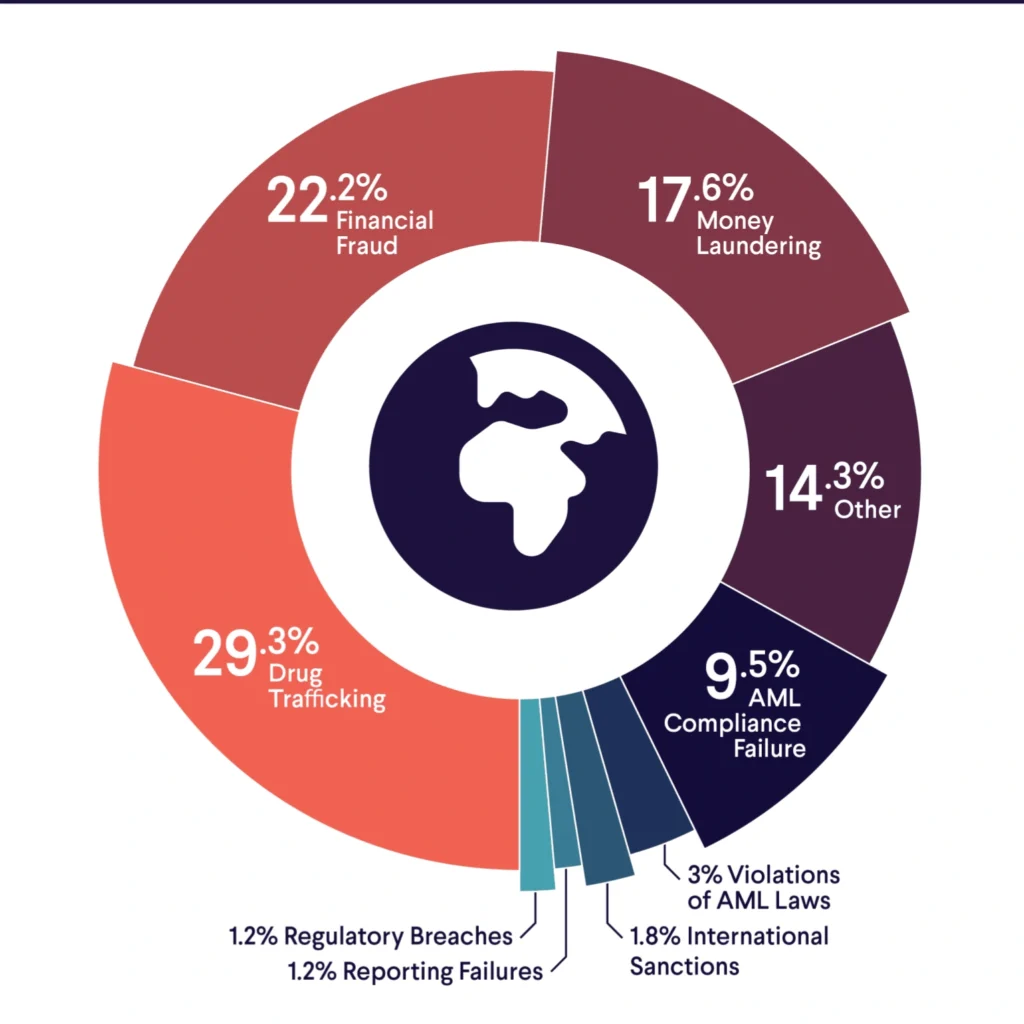Money laundering is an age-old financial crime. But it’s taking new forms and propagating through evolved means in 2025, presenting new challenges and complexities for regulatory bodies and financial institutions worldwide.
Understanding the latest statistics and trends becomes crucial for mitigating this risk as criminals adapt new strategies.
This blog post dives into the latest money laundering statistics, highlighting major threats, and emerging methodologies. We’ll also discuss the best ways to prevent money laundering.
Money laundering in 2025: an overview
Money laundering remains a pressing issue in 2025. Criminals use clever tactics to hide the origins of their illegal funds and defy prevention mechanisms.
Per the United Nations Office on Drugs and Crime report, 2-5% of the global GDP is lost to money laundering every year. This amounts to approximately $2 trillion annually! Insane, right?
Here’s an industry-wise breakdown of recent money laundering statistics and trends worldwide—
Money laundering statistics by industry

1. Financial Services
About 50% of money laundering cases in Latin America involve financial firms.
Did you know? TD Bank paid a record-breaking $1.3 billion fine in 2024 for violating the Bank Secrecy Act and money laundering. This was the largest fine ever paid by a bank in the United States for Bank Secrecy Act violations.
2. Crypto
The rise of digital money laundering through cryptocurrencies has surged immeasurably. This is due to the anonymity they provide.
The total amount of money laundered through Bitcoin since its inception in 2009 is about USD 4.5 billion!
3. Gaming
Criminals create multiple fake gaming accounts to convert illegal funds into in-game currency and transfer them among themselves. They then sell these items or characters on secondary markets, concealing the money’s origin.
In 2022, a gaming company in Malta was fined €386,000 for failing to comply with money-laundering laws.
Here are some other statistics that will help you understand the current state of money laundering across the world—

- The U.S. Department of the Treasury estimates that around $300 billion is funneled through illicit financial activities in the country each year.
- A Fenergo report revealed that in 2020, financial institutions worldwide faced a staggering $10.4 billion in fines for non-compliance with AML, KYC, data privacy, and MiFID regulations.
- In 2019, illicit transactions accounted for approximately 2.1% of all cryptocurrency transfers, totaling nearly $21.4 billion.
- Within UK, money laundering plays a significant role in driving serious and organized crime, which carries an estimated annual social and economic impact of £24 billion.
The cost of money laundering
Money laundering carries hefty financial and social costs that ripple through economies and communities. Let’s break these down with some real-world examples to illustrate the impact.
1. Financial costs
From systemic financial failures to hindered growth and development, money laundering induces financial instability across the nation, in multiple forms.
Economic distortion
When criminals pour laundered money into real estate, it can artificially inflate property prices. In Vancouver, Canada, this phenomenon priced out many legitimate buyers, creating a housing crisis. Local families found themselves unable to afford homes in their city, all because criminals needed somewhere to park their unlawful gains.
Systemic financial failures
Banks caught up in money laundering schemes often face massive fines and reputational damage. Take the case of HSBC, which was fined $1.9 billion in 2012 for allowing drug cartels to launder money through its branches.
In 2021 again, a money-laundering ring moved $4.2 billion through HSBC accounts in Hong Kong, raising concerns about the bank’s internal controls and disclosure practices. Such incidents not only hurt the bank but also shook customer confidence in the entire banking sector.
Lost tax revenue
When money is laundered, it often evades taxation. This means less funding for public services like healthcare, education, and infrastructure.
For example, a Florida developer defrauded investors of more than $30 million while evading $2.5 million in U.S. income taxes and penalties in July 2023. To launder this money, the developer misused legal entities and purchased several real estate properties using discrete LLCs.
Hindered economic growth
Shareholders and potential investors often react swiftly to news about AML scandals. This shrinks stock prices and creates difficulty in raising capital.
In developing regions like Sub-Saharan Africa, illicit flows have drained 1.3 trillion dollars since 1980, impacting development and increasing poverty.
2. Social costs
The social impact of money laundering goes beyond numbers on a balance sheet. It robs economies of resources and the trust that holds communities together.
Fueled crime
Money laundering provides the lifeblood for criminal activities. In Mexico, drug cartels launder an estimated $25 billion annually, allowing them to expand their operations, buy weapons, and corrupt officials. This perpetuated a cycle of violence that has claimed thousands of lives and destabilized entire regions.
Undermined Democracy
Laundered money often finds its way into political campaigns, corrupting the democratic process. In Brazil’s ‘Operation Car Wash’ scandal, billions in laundered funds were funneled to politicians. This led to a disfigured political system and social unrest.
Exploitation of vulnerable populations
Money launderers often exploit the poor and marginalized. For mule accounts and human trafficking operations, they trap numerous innocent people. IMF also highlights that reduced public resources and facilities affect marginalized sections the most.
Economic inequality
As laundered money concentrates wealth in the hands of criminals, it increases economic inequality among the general population. This widening gap can lead to social tensions and unrest, as seen in countries like Russia, where oligarchs’ wealth, often tied to money laundering, stands in stark contrast to the average citizen’s struggles.
How to prevent money laundering?
Identity fraud is one of the fastest-growing financial crimes. Banks and financial institutions are the most affected sectors by this crime. As of 2020, they have suffered $20 billion in losses due to the same.
How are synthetic identities and money laundering correlated? Criminals use synthetic identities to open mule accounts in banks and fintech platforms. A major portion of illicit money is moved through these accounts.
Criminals may obtain personal information like SSNs from the dark web and data breaches to create synthetic identities. They fabricate it with other details like birthdate, address, etc. Advanced fraudsters can even create entire digital footprints including social media profiles and fake employment records.
According to a report by Fedpayments Improvements, 1% to 3% of bank accounts in the U.S. were opened using synthetic identities. About 2.5 million such accounts might be involved in moving illicit funds.
It’s harder to detect crime because money moves through multiple accounts and the initial source remains untraced. What’s more concerning is, synthetic identity fraud will account for losses worth $23 billion by 2030.
This highlights the pressing need for organizations to implement stringent measures. By implementing robust identity verification processes, businesses can effectively mitigate these risks and protect themselves from financial crime.
AML solutions can enhance and strengthen compliance efforts here by leveraging AI-driven automation, ensuring adherence to regulations like Know Your Customer (KYC), and enabling continuous monitoring of customer transactions.
Take the case of Danske Bank—Denmark’s largest financial institution, which faced a major money laundering scandal in 2023, with its Estonian branch accused of processing over €200 billion in illicit funds between 2007 and 2015. Investigations revealed that the bank ignored multiple warnings and failed to implement robust anti-money laundering (AML) measures, allowing high-risk clients access to the U.S. financial system.
AI-powered AML enhancements
To rebuild trust, Danske Bank integrated AI-driven AML solutions:
- Smarter transaction monitoring: Machine learning detects suspicious activity in real-time
- Big Data analytics: AI uncovers hidden laundering patterns within vast datasets
- Predictive risk models: Historical data improves anomaly detection accuracy
- Automated compliance: AI ensures swift reporting of flagged activities
By adopting AI, Danske Bank strengthens its fraud detection, ensuring stricter compliance and a more secure financial ecosystem.
Conclusion
Strong regulatory compliance and identity verification checkpoints during onboarding continue to be a business’s first and strongest defense mechanism against identity fraud. AML/KYC solutions are non-negotiable for financial institutions focused on managing risk effectively. They help strike a delicate balance between security, compliance, and customer experience.
Industry experts also vouch for advanced AML solutions to mitigate risk. Ramesh Laxminarayan, CIO of HDFC bank says traditional systems struggle with real-time fraud detection. ‘Machine learning and AI-based systems are essential’, he adds.
According to Olivia Conjeaud, McKinsey partner, there is a lot of room for progress. She believes some organizations are still stuck at basic KYC processes and need to upgrade. By not adapting to the newest tools, they waste resources on low-impact activities.
HyperVerge’s AML solutions offer efficient compliance tools with custom filtering based on DOB and country to reduce false positives. Plus, the system ensures accurate AML screening by filtering out non-relevant profiles and delivering real-time updates on sanctions, PEPs, and adverse media every seven minutes.
Stay at the forefront of financial risk management frameworks with Hyperverge’s AML solutions.
Book your demo to see its capabilities in action.
FAQs
1. What is the most common form of money laundering?
The most common forms of money laundering are smurfing, manipulation of invoices and trade transactions, forming shell companies, casino laundering, and using anonymous digital currencies (cryptocurrencies).
2. What percentage of cash is laundered?
According to the United Nations Office on Drugs and Crime (UNODC), $800 billion to $2 trillion, or 2-5% of global GDP, is laundered annually.
3. What state has the most money laundering?
The Southern District of New York recorded the highest number of individuals sentenced for money laundering offenses at 69. Following closely is the Western District of Missouri with 68, and the Southern District of Florida with 52





